THE BOTANICAL LEGACY OF YING DOON MOY
Written by Paul Cox, Acting Superintendent, San Antonio Botanical Garden
A Tale about Papayas – 1999
In the old days at the Botanical Garden, we used to grow papayas for their bold tropical effect. They were nothing special, just some fruits we purchased at El Mercado. Mainly they were planted around the Formal Gardens or used as accents in the color beds. At that time Mr. Moy was the horticulturist in charge of this area. After a few years, we began to notice some changes in the papayas. The plants were getting shorter and regularly maturing fruits in one season.
Moy finally came forward and said he had been crossing and selecting certain specimens based mostly on sizes. His first goal was to produce large and fruited, early maturing varieties. This was very successful as he was turning out 25-pound fruits that were ready around the end of September. Visitors were amazed to see these huge fruits on these exotic plants. I would tell them they were "Watermelon trees" or "Texas Figs."
Impressive as these plants were, the fruits were relatively tasteless. To improve the flower, Moy began crossing the popular Hawaiian strain into his line. The problem with this was that the only way he could test the flavor of his plants was to “get us to eat them”. Aware of the impressive yield of up to 235 pounds of fruit per plant in one season, staff began to run away when they saw Moy approaching with papayas in hand.
To solve this situation, we obtained a sugar refractometer from Dr. Jerry Parsons of the Texas Agricultural Extension Service. This enabled Moy to scientifically quantify the sugar content of his fruits.
In time the papayas became our signature plant. We featured them throughout the formal areas, and they received much acclaim. It was the papayas that gained Moy the recognition which won him his first awards.
When the papayas, however, were deemed inappropriate and banished from the Formal Garden, a new era began for Mr. Moy. The tropical plants were relocated to an obscure portion of the facility (now known to the staff as "Moy land") and Moy was relieved of his command.
"Look at the Size of Them Dudes!" - 1990
There are a few most-asked questions Botanical Center employees can count on. Hands down, from late spring through the summer they can expect one that occurs as soon as a visitor enters the grounds: "What is THAT plant with all those big fruits?" Or from the savvier, "What do you do with those papayas? “Who gets to eat them?" followed by a hopeful look.
"That plant" is usually found in tropical zones, and if found outside those zones, papayas are simply ornamental, fast growing, spectacular trees that provide almost 'instant' shade for annual beds. At the Botanical Center, they produce edible fruits, and how that happens is a story almost as interesting as the person responsible for twenty-pound papayas --- Ying Doon Moy.
Mr. Moy came to the United States in 1980 after 25 years as a professor and geneticist in Canton, China, where he performed genetic research on more than a 100 varieties of fruit. His research at the Botanical Center encompasses the papaya and production of more drought tolerant plants. His methods were recognized for vision and creativity with the prestigious "Imagineer Award" presented by the Mind-Science Foundation.
So that local gardeners may duplicate Mr. Moy's papaya success, we offer excerpts from his articles printed in the North San Antonio Times.
“Papaya is a perennial tropical fruit tree. It can grow in San Antonio, but because of our climate, only as an ornamental. Can we change this and harvest matured fruit? Research at the Botanical Center since the early 1980’s shows we can. With a little care and patience, San Antonio gardeners can produce this heavenly fruit.
1. Use the Mexican papaya variety. It grows fast and can tolerate low springtime temperatures. They are ready to bloom when the weather warms. Plant papaya seeds in a greenhouse or similar area by the first of December.
2. Plant seedlings from the greenhouse in the last week of February or first week of March after the last freeze has passed. When the height of the seedling is about 15 inches, the diameter is about 3/8 of an inch, the leaves are dark green and big, with no diseases or pests, it is ready to be transplanted outside. We have only nine months from planting to harvest, so we need strong seedlings.
3. Good care. Papayas need a loam, well-drained soil with a pH of 6 to 8. These trees need a great deal of fertilizer to make them grow faster and produce large fruit. Always keep the leaves dark green by feeding every two months with 4 to 6 ounces of 20-20-20 granular fertilizer. Liquid fertilizer and chelated iron should be applied if leaves begin to yellow.
4. Papayas need a lot of water. Keep the ground moist for best growth, but don't let the water stand or the roots may rot. Cultivate the soil and remove weeds to reduce competition. Papayas are sometimes attacked by scale, mealy bugs and red spiders. If you find these pests, they should be sprayed as soon as possible.
5. Pollinating. To get big fruit, we must help nature a little. If you did everything right, your papaya will bloom at the end of May or the first of June. In San Antonio, this time is still too cool for many bees or butterflies to visit your garden. But it is important that the flowers be pollinated now to produce fruit and give it time to mature.
For this reason we must hand-pollinate the flowers. The papaya has three kinds of flowers - male, female and bi sexual. The trees are female, male and hermaphrodite. Since only the male flower produces sufficient pollen (the bisexual flower produces some but not enough), you need to plant one or two male plants for pollinating. According to the research, 15-24 female plants only need one male tree for good pollination.
To hand pollinate, pluck off the male flower from 10 a.m. to noon and open the anther, let the pollen appear and then bring this flower to the female flower. Open the anther and touch the female flower stigma carefully, don't hurt it, and let pollen fall upon the surface of the stigma. The pollinating is finished. Then with plenty of moisture and fertilizer, we should have papaya fruits by the end of fall.”
At the Botanical Center, we grow more male plants than are required for pollination, because they are very beautiful in their own way, without the production of fruit. Male plants produce masses of whitish-yellow flowers and make a very attractive ornamental tree.
See video at:
http://aggie-horticulture.tamu.edu/archives/video/detail.php?vidid=22&size=largevid
More about Mr. Moy:
http://plantanswers.com/heroes/YingDoonMoy.html
Papaya Recipes:
http://plantanswers.com/Articles/Documents/PapayaRecipes.pdf
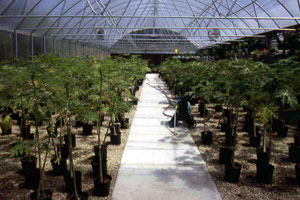
1. Papaya seedlings in greenhouse
|
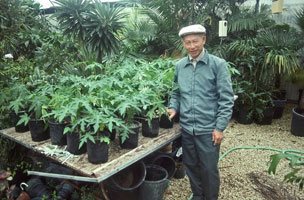
2. Mr. Moy with Papaya seedlings
|
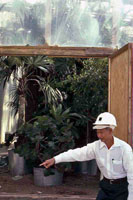
3. Mr. Moy puts plants into greenhouse for winter
|
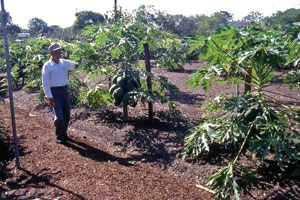
4. Moy with his large fruited, early ripening papayas
|
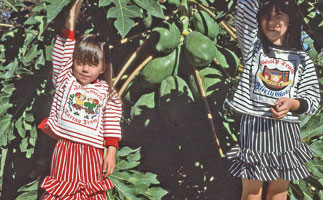
5. Cox girls with Moy's Large papayas
|
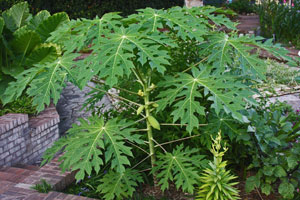
6. Female Papaya with stages of small fruit
|
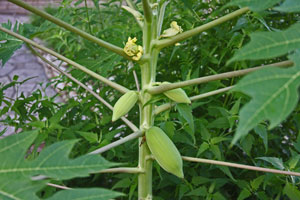
7. Female Papaya bloom stages from small at top
|
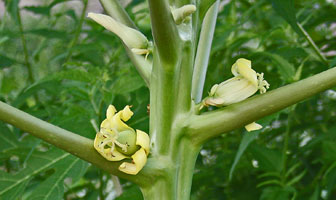
8. Young Female Papaya blooms with stigma showing
|
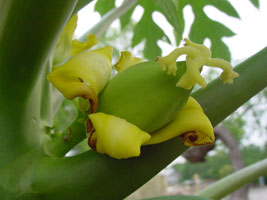
9. Female Papaya bloom close-up
|
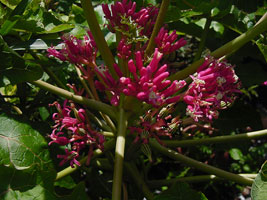
10. Male Ornamental Papaya
|
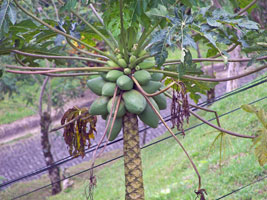
11. Papayas At Hanging bridges in Costa Rico
|
|
|



